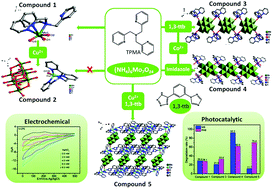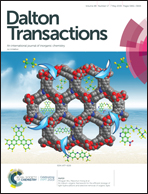Isopolymolybdate-based inorganic–organic hybrid compounds constructed by multidentate N-donor ligands: syntheses, structures and properties†
Abstract
Taking advantage of isopolymolybdate [(NH4)6Mo7O24·4H2O] as a POM building block with multidentate N-donor molecules (tris[(2-pyridyl)methyl]amine = TPMA, 1-(tetrazo-5-yl)-3-(triazo-1-yl)benzene = 1,3-ttb) as organic ligands, five different inorganic–organic hybrid compounds were synthesized and characterized by single-crystal X-ray diffraction, infrared spectroscopy (IR) and powder X-ray diffraction (PXRD). Compound 1 is a Mo(VI)-based structure in which the TPMA ligand shows a tridentate coordination mode, which bears an uncoordinated pyridyl arm, and can further react with transition metals. Compound 2 exhibits a Cu(II)-based zero-dimensional (0D) structure consisting of the TPMA ligand and [β-Mo8O26] polyanion. Compounds 3 and 4 have the same molecular formula with slight structural differences; both have the Co(II)-based one-dimensional (1D) chain structure. Compared to the β-Mo8O26 polyanion in compound 3, the [Mo8O28]8− units condense via sharing two common terminal O atoms to form infinite [Mo8O26]n4n− chains in compound 4. Compound 5 is a Cu(II)-based two-dimensional (2D) layer structure consisting of TPMA and 1,3-ttb mixed ligands and [β-Mo8O26]. In addition, the electrochemical properties and photocatalytic activities for the degradation of two types of organic dyes were explored for several compounds.



 Please wait while we load your content...
Please wait while we load your content...